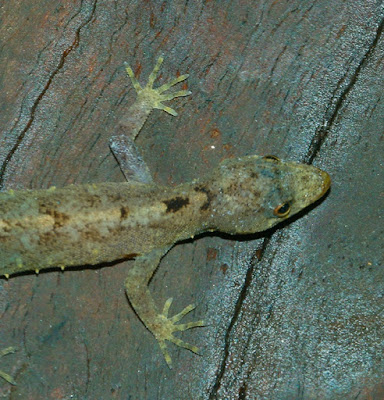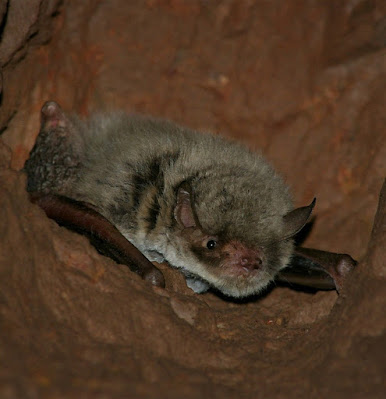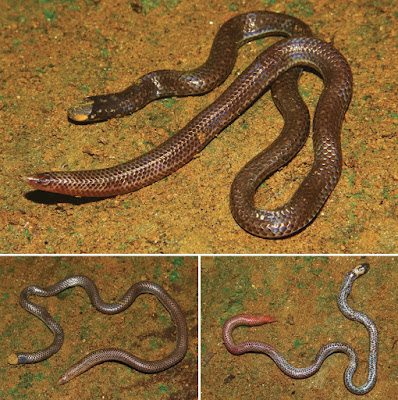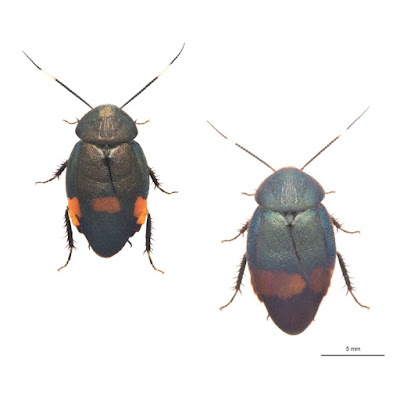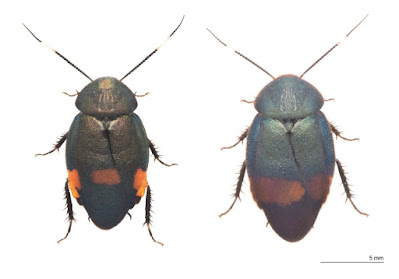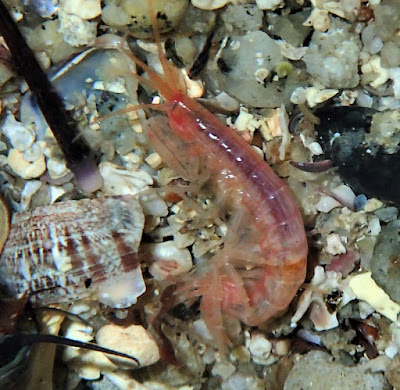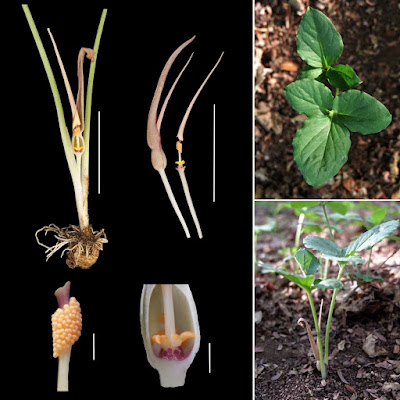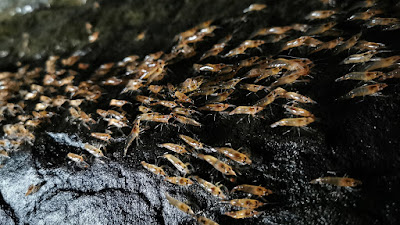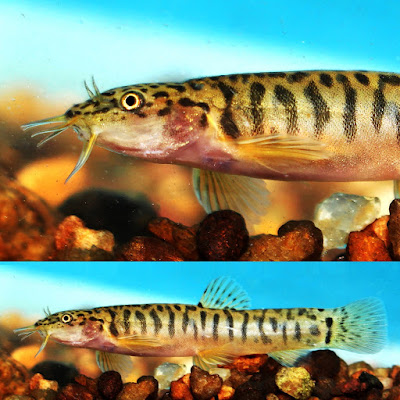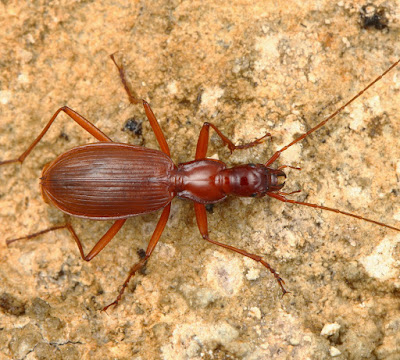[Most Recent Entries] [Calendar View]
Sunday, November 29th, 2020
| Time | Event | ||||
| 4:03a | [Herpetology • 2020] Cnemaspis ranganaensis • A New Cnemaspis Strauch, 1887 (Squamata: Gekkonidae) from the northern Western Ghats, Maharashtra, India
Keywords: Reptilia, arboreal species, Cnemaspis ranganaensis sp. nov., gecko, systematics  Cnemaspis ranganaensis sp. nov. Amit Sayyed and Shauri Sulakhe. 2020. A New Cnemaspis Strauch, 1887 (Squamata: Gekkonidae) from the northern Western Ghats, Maharashtra, India. Zootaxa. 4885(1); 83–98. DOI: 10.11646/zootaxa.4885.1.5 | ||||
| 4:13a | [Mammalogy • 2020] Back to Life and to Taxonomy: New Record and Reassessment of Myotis bucharensis (Chiroptera: Vespertilionidae)
Abstract Myotis bucharensis is one of the least studied Palaearctic bat species, known from only three localities in Tajikistan and Uzbekistan and not reported since 1965. In autumn 2019, a male Myotis captured in Zerafshan river basin in Tajikistan was later identified as M. bucharensis based on tail and tibia proportions and strongly displacement of posterior small premolars. The identification was then confirmed by morphometric analyses supporting that M. bucharensis is specifically different but represents a part of the Myotis frater complex. Analyses of one mitochondrial (cyt b) and one nuclear gene (RAG2) were performed for the first time for M. bucharensis. According to these genetic results, this form is indeed a member of the «daubentonii» clade, which includes all known frater-like Myotis, and most likely represents a sister species to M. longicaudatus. Record of the alive specimen M. bucharensis has valuable implication for bat conservation in Tajikistan. Keywords: Mouse-eared bats, new record, morphometry, taxonomy, Central Asia, Tajikistan, mtDNA Myotis bucharensis Kuzyakin, 1950 Denis V. Kazakov, Ilya V. Artyushin, Tolibjon K. Khabilov, Dilbar E. Tadzhibaeva and Sergei V. Kruskop. 2020. Back to Life and to Taxonomy: New Record and Reassessment of Myotis bucharensis (Chiroptera: Vespertilionidae). Zootaxa. 4878(1); 129–144. DOI: 10.11646/zootaxa.4878.1.5 | ||||
| 7:20a | [Herpetology • 2020] Rhinophis karinthandani • A New Indian Species of Rhinophis Hemprich, 1820 closely related to R. sanguineus Beddome, 1863 (Serpentes: Uropeltidae) from the Western Ghats of peninsular India
Abstract A new species of the uropeltid (shieldtail snake) genus Rhinophis is described based on a type series of seven specimens from the Wayanad region of the Western Ghats of peninsular India. The holotype was collected before 1880 but had been misidentified as the phenotypically similar and parapatric (possibly partly sympatric) R. sanguineus. Rhinophis karinthandani sp. nov. is diagnosed by a combination of 15 dorsal scale rows at midbody, 4–8 pairs of subcaudal scales, colour pattern (uniformly dark above, whitish below with extensive dark mottling), and by its distinct mitochondrial DNA sequences (e.g. >7.6% uncorrected p-distance for nd4). Phylogenetic analysis of mitochondrial DNA sequence data indicates that the new species is most closely related to R. sanguineus among currently recognised species, with this pair most closely related to the partly sympatric R. melanoleucus. The new species description brings the number of currently recognised species in the genus to 24, six of which are endemic to India and 18 endemic to Sri Lanka. A new key to the identification of Indian species of Rhinophis is provided. Keywords: identification key, Rhinophis microlepis, shieldtail, snakes, Wayanad, Western Ghats, Reptilia Rhinophis karinthandani sp. nov. Chresonymy: Rhinophis sanguineus Beddome, 1863: Cyriac et al. 2020, in part (see Appendix 1) Diagnosis. Rhinophis karinthandani sp. nov. differs from all other species of Rhinophis except R. fergusonianus Boulenger, 1896, R. melanoleucus, and R. sanguineus in having 15 dorsal scale rows at (or just behind) midbody (versus 17 or 19 in other congeners). Rhinophis karinthandani sp. nov. differs from R. fergusonianus and R. melanoleucus in having a reduction from 17 to 15 dorsal scale rows that occurs anterior to the 80th ventral (versus posterior to the 90th ventral in R. fergusonianus and posterior to the 99th ventral in R. melanoleucus: Cyriac et al. 2020), and in having dark spots or speckles ventrally (versus dark blotches). Rhinophis karinthandani sp. nov. differs from R. melanoleucus also in having fewer ventrals (< 206 versus > 217) and fewer subcaudals (in males: 4–5 versus 6–7). The new species is most similar superficially to the parapatric (possibly partly sympatric) R. sanguineus, but the two species can be distinguished on the basis of the former having fewer subcaudals (left-right means of 4–5 in females and 6.5–8 in males versus 5–7 and 8.5–10.5, respectively), having a reduction from 19 to 17 dorsal scale rows that occurs anterior to the 34th ventral (mean 28th ventral [n = 18 sides]; versus posterior to the 26th ventral, mean 34 [n = 28]) and a reduction from 17 to 15 dorsal scale rows that occurs anteriorly to the 78th ventral (mean 68th ventral [n = 18 sides]; versus posterior to the 67th ventral, mean 79th [n = 28]) (Appendix 4; Cyriac et al. 2020), in mitochondrial DNA sequences (e.g. >7.6% uncorrected p-distance for nd4: Table 1), and in colour pattern. In terms of colour pattern, both species have a dark dorsum and generally pale venter, but R. karinthandani sp. nov. has an extensively darkly mottled or speckled or spotted venter, except for a narrow (approximately one scale wide, generally across second and third and/or third and fourth dorsal scale rows), longitudinal, ventrolateral pale line along each side, immediately below the dark dorsum (and sometimes other, subparallel pale lines further ventrally), whereas R. sanguineus has a less mottled venter with the paler colour below the darker dorsum being much more extensive than a narrow regular line. In life, the paler venter of R. karinthandani sp. nov. is whitish (to pale pinkish more anteriorly), but in R. sanguineus is a vivid red (paler in smaller specimens, see Discussion). The colour pattern differences in preservation hold well for almost all specimens we have identified, although in R. sanguineus specimen VPRS0918093, many of the mostly pale scales in the broad pale areas below the darker dorsum have small blackish dots. At least in life, the dorsal colour of R. sanguineus appears to be darker, more blackish than in R. karinthandani sp. nov. Photographs of the type specimens of R. sanguineus and its junior synonym R. microlepis are presented in Figs. 4 and 5. Etymology. The species is named in honour of Karinthandan, a member of the Paniya (also Paniyar, Paniyan) tribe indigenous primarily to the tri-state region of Kerala-Karnataka-Tamil Nadu. Karinthandan is believed to have been a chieftain (= moopan) who was murdered in the 1700s by colonial British after he showed them the Thamarassery churam mountain pass between the Adivaram (foothills) and Wayanad plateau. Legend has it that Karinthandan’s spirit is today chained to a banyan tree at Lakkidi (a paratype locality of the new species), which has become a place of worship. In addition, Karinthandan in Malayalam is from “kari” meaning black and “thandan” (thandu) meaning stem or backbone, which also seems appropriate given the blackish dorsal colour of the newly described species. For nomenclatural purposes, the species epithet is considered a noun in apposition. Filipa L. Sampaio, Surya Narayanan, Vivek P. Cyriac, Govindappa Venu and David J. Gower. 2020. A New Indian Species of Rhinophis Hemprich, 1820 closely related to R. sanguineus Beddome, 1863 (Serpentes: Uropeltidae). Zootaxa. 4881(1); 1–24. DOI: 10.11646/zootaxa.4881.1.1 | ||||
| 8:03a | [Entomology • 2021] Eucorydia donanensis & E. tokaraensis • Two New Species of the Genus Eucorydia (Blattodea: Corydiidae) from the Nansei Islands in Southwest Japan
Abstract Two new species of the cockroach genus Eucorydia Hebard, 1929 from the Nansei Islands in Southwest Japan were compared to two closely related congeners, Eucorydia yasumatsui Asahina, 1971 and Eucorydia dasytoides (Walker, 1868). Eucorydia donanensis Yanagisawa, Sakamaki, and Shimano sp. nov. from Yonaguni-jima Island was characterized by an overall length of 12.5–14.5 mm in males. The dorsal side of the male abdomen was entirely dark purple and there was an obscure orange band running down the middle of the tegmen. Eucorydia tokaraensis Yanagisawa, Sakamaki, and Shimano sp. nov. was characterized by an overall length of 12.0–13.0 mm in males and a distinct orange band running down the middle of the tegmen. Eucorydia yasumatsui, E. donanensis, E. tokaraensis and the zonata population of E. dasytoides were divided into four lineages in a maximum-likelihood tree generated from a dataset concatenated from five (two nuclear, 28S rRNA, histone H3, and three mitochondrial, COII, 12S rRNA, 16S rRNA) genes. We recognized the three Japanese lineages E. yasumatsui, E. donanensis, and E. tokaraensis as distinct species, which were also supported by the pairwise genetic distances (5.4–7.8%, K2P) of the COI sequences. Morphometric analysis was performed on the genitalia. A principal component analysis plot revealed that the sizes of the genitalia in the three Japanese species were similar to each other and smaller than that of the zonata population of E. dasytoides. The analysis also revealed that the three Japanese species were distinguished from each other by combinations of the sizes of L3 and L7 sclerites and the shape of R2 sclerite, with some overlapping exceptions. Shizuma Yanagisawa, Shimpei F. Hiruta, Yositaka Sakamaki, Jhih-Rong Liao and Satoshi Shimano. 2020. Two New Species of the Genus Eucorydia (Blattodea: Corydiidae) from the Nansei Islands in Southwest Japan. Zoological Science. 38(1) DOI: 10.2108/zs200048 | ||||
| 8:03a | [Crustacea • 2020] Species of the Maera-clade (Amphipoda: Maeridae) collected from Japan. Part 4: Addenda to Genera Maera Leach, 1814 and Quadrimaera Krapp-Schickel & Ruffo, 2000, with Revised Keys to Japanese Species of the Clade
Abstract Two new species of Maera Leach, 1814 and Quadrimaera Krapp-Schickel & Ruffo, 2000 included in the Maera-clade are described from Japan. Maera denticoxa sp. nov. was collected from Iwate and Hokkaido Prefectures and can be distinguished from its congeners by the small notches on the posteroventral margins of coxae 1–6. Quadrimaera angulata sp. nov. from north of Tanegashima Island in Kagoshima Prefecture is characterized by the distal tooth on the mandibular palp article 1, the rounded palm of the female gnathopod 2, and the angular posterodistal margin of the pereopod 7 basis. Keys to Japanese species of the Maera-clade are provided. In total, seventeen species included in the clade occur in Japan. Keywords: Crustacea, Taxonomy, Iwate, Hokkaido, Tanegashima Island, new species, key Maera denticoxa sp. nov. Hiroyuki Ariyama, Masafumi Kodama and Ko Tomikawa. 2020. Species of the Maera-clade collected from Japan. Part 4: Addenda to Genera Maera Leach, 1814 and Quadrimaera Krapp-Schickel & Ruffo, 2000, with Revised Keys to Japanese Species of the Clade (Crustacea: Amphipoda: Maeridae). Zootaxa. 4885(3); 336–352. DOI: 10.11646/zootaxa.4885.3.2 | ||||
| 8:06a | [Botany • 2020] Typhonium sagaingense (Araceae) • A New Areae Species from Sagaing Region [Taxonomic Studies of Araceae in Myanmar I] Abstract A species new to science, Typhonium sagaingense from Sagaing Region, Myanmar, is herein described and illustrated. It is similar to T. albidinervum and T. filiforme but differs in having following characters: trifoliolate leaves, spadix slightly shorter than spathe, fewer yellow staminodes arranged in one whorl and pink appendix. Detailed descriptions, colour plates, illustration, distribution, phenology and ecology of the new species are provided, including a key to all Typhonium occurring in Myanmar. Keywords: Monocots, Aroideae, Biodiversity, Plant taxonomy, Southeast Asian Flora, Tropical botany Mark Arcebal K. Naive, Khant Zaw Hein, Zheng-Xu Ma and Nguyen Van Du. 2020. Taxonomic Studies of Araceae in Myanmar I: Typhonium sagaingense, A New Areae Species from Sagaing Region. Phytotaxa. 471(1); 47–53. DOI 10.11646/phytotaxa.471.1.5 | ||||
| 8:12a | [Crustacea • 2020] Why do Shrimps leave the Water? Mechanisms and Functions of Parading Behaviour in Freshwater Shrimps
Abstract An understanding of the mechanisms and functions of animal migratory behaviour may provide insights into its evolution. Furthermore, knowledge about migration may be important for conservation of rare species and may help to manage species in a rapidly changing world. Upstream migration is common in riverine animals, but little is known about proximate cues and functions of the upstream migration in aquatic macroinvertebrates. In Ubon Ratchathani, Thailand, locals have observed a synchronous mass migration of freshwater shrimps on land. This so‐called ‘parading behaviour' occurs annually during the rainy season and has become a large ecotourism event. Yet, we know little about the natural history, proximate causation and function of this extraordinary behaviour. Here we describe the natural history of parading behaviour and report the results from a series of experiments and observations to address its mechanisms and functions. Parading behaviour is not associated with breeding and spawning; rather, shrimps leave the water to escape strong currents. Conditions promoting shrimps to leave the water include low light, high water velocity and low air temperature. In addition, there is variation explained the specific location. River topology that creates hydrological variability and turbulence plays a role in triggering the shrimps to move out of water. Furthermore, turbidity and water chemistry were associated with shrimp activity. Finally, our results support that parading behaviour in freshwater shrimps is a mass movement upstream due to hydrological displacement. This study highlights the mechanisms that stimulate parading behaviour; a common activity in Macrobrachium and other decapod crustaceans. Keywords: collective movement, freshwater prawn, Macrobrachium dienbienphuense, migration, Southeast Asia
W. Hongjamrassilp, W. Maiphrom and D. T. Blumstein. 2020. Why do Shrimps leave the Water? Mechanisms and Functions of Parading Behaviour in Freshwater Shrimps. Journal of Zoology. DOI: 10.1111/jzo.12841 These Shrimp Leave the Safety of Water and Walk on Land. But Why? A biologist decided to investigate a shrimp parade that attracts thousands of tourists in a province of Thailand. | ||||
| 8:54a | [Ichthyology • 2020] Indoreonectes telanganaensis • A New Species of Loach (Teleostei: Nemacheilidae) from the Godavari Basin of India
Abstract A new species of hill-stream loach, Indoreonectes telanganaensis, is described from a seasonal tributary of the Godavari River at Maisamma Loddi, within the Kawal Tiger Reserve, Telangana State, India. The new species is distinguished from its congeners by a combination of characters including caudal peduncle as long as deep; eye large, its diameter about one-fifth head length; pectoral fin as long as head; nasal barbel reaching the middle of the eye; dorsal-fin origin on vertical through pelvic-fin origin; and bars on the lateral side of the body well defined and wide. We also provide multivariate morphometric, and DNA analysis based on the mitochondrial cytochrome b gene sequence to support the distinction of the new species. Keywords: Telangana loach, hillstream loach, molecular phylogeny, Telangana State, Pisces Kante Krishna Prasad, Chelmala Srinivasulu, Aditya Srinivasulu, V. K. Anoop and Neelesh Dahanukar. 2020. Indoreonectes telanganaensis, A New Species of Loach (Teleostei: Nemacheilidae) from the Godavari Basin of India. Zootaxa. 4878(2); 335–348. DOI: 10.11646/zootaxa.4878.2.7 | ||||
| 9:08a | [Entomology • 2020] New Species and New Record of Cavernicolous Ground Beetles (Coleoptera: Carabidae: Pterostichini and Platynini) from Sichuan Province, China Abstract Two new species of cave-adapted ground beetles are described and illustrated from Sichuan Province, southwestern China: Jujiroa zhouchaoi sp. nov. from the calcareous conglomerate cave Shenxian Dong in Mt. Zhaogong (Dujiangyan, Chengdu) and Pterostichus (Huaius) hanwang sp. nov. from the limestone cave Hanwang Dong (Chaotian, Guangyuan). A new locality for Jujiroa deliciola Uéno and Kishimoto, 2001 is given. Keys to species of the genus Jujiroa Uéno, 1952 and the subgenus Huaius Tian and Huang, 2019 (in Tian et al. 2019) are also provided. Keywords: new species, carabids, subterranean, Coleoptera Jujiroa deliciola Uéno and Kishimoto, 2001 Mingyi Tian and Li He. 2020. New Species and New Record of Cavernicolous Ground Beetles from Sichuan Province, China (Coleoptera: Carabidae: Pterostichini and Platynini). Zootaxa. 4881(3); 545–558. DOI: 10.11646/zootaxa.4881.3.7 |
| << Previous Day |
2020/11/29 [Calendar] |
Next Day >> |
